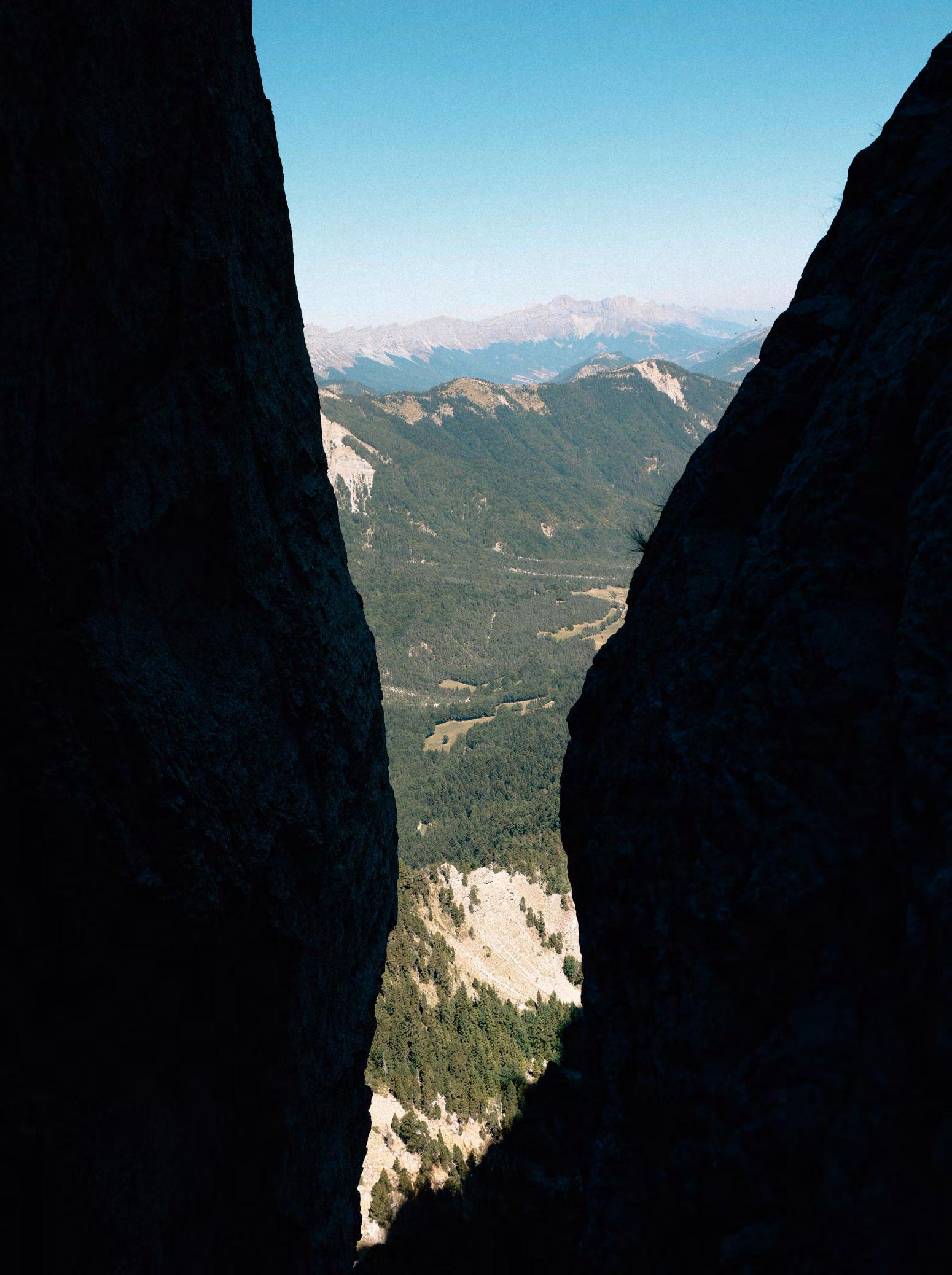
2
3
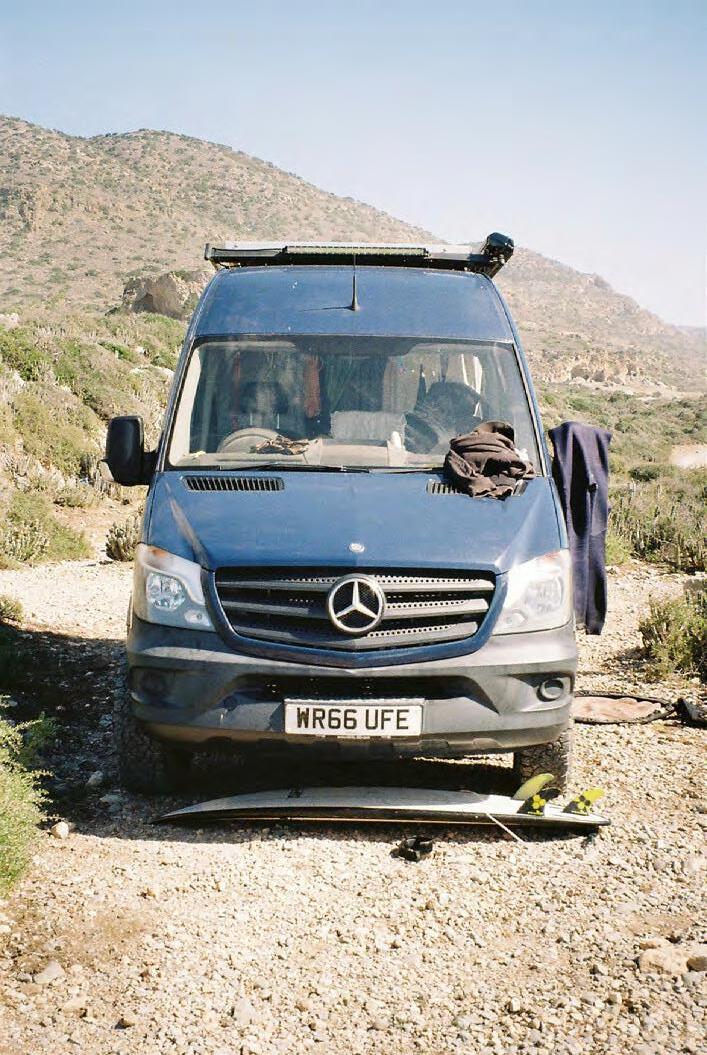

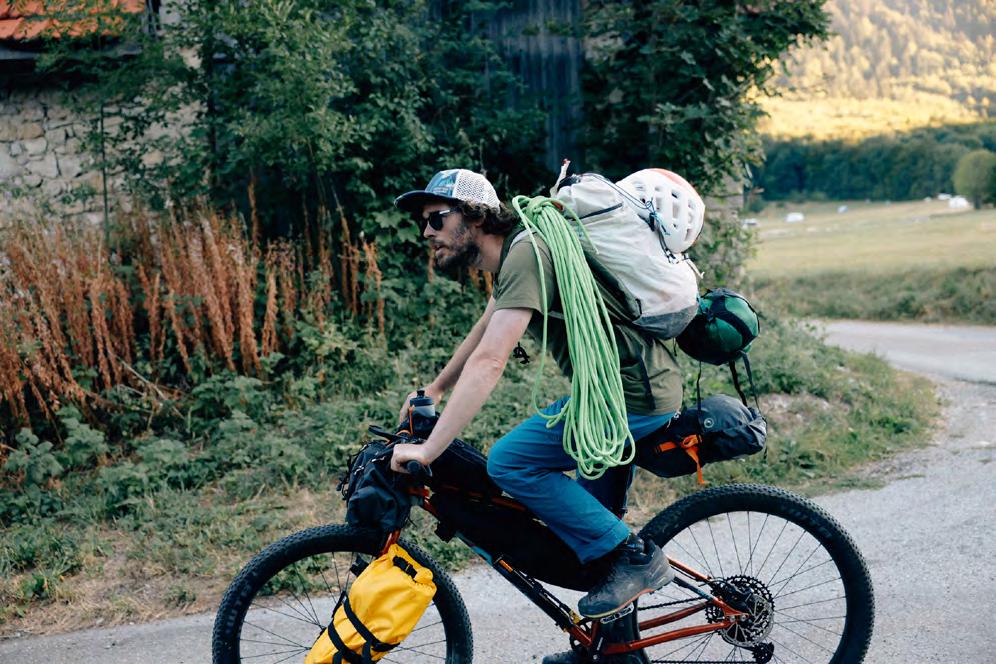



[Issue 01]

[01]
Printed [January 2024]
No. Copies [20]
Paper [100% Recycled Uncoated]
Typefaces [Chakra Petch, Clash, Lanai, Martian, Satoshi, Sentient]
Cover Photo [Jean-Baptiste Delorme]
Editor [Izzy Wedderburn]
Creative Direction [Izzy Wedderburn]
Contact [hello@izzyweds.com] [www.izzyweds.com]
Imprint
All Rights Reserved
Original Freedom
[©]
10
Contributors
Juliette Charpentier [Illustrator]
Jean-Baptiste
Delorme
[Photographer]
Fin
MacMillan
[Photographer]
Alice
Poole
[Photographer]
Izzy Taylor [Researcher]
Olivia
Thurlow Mills
[Editor & Copy Writer]
Izzy
Wedderburn [Graphic Designer]
Rosie
Yates [Illustrator]
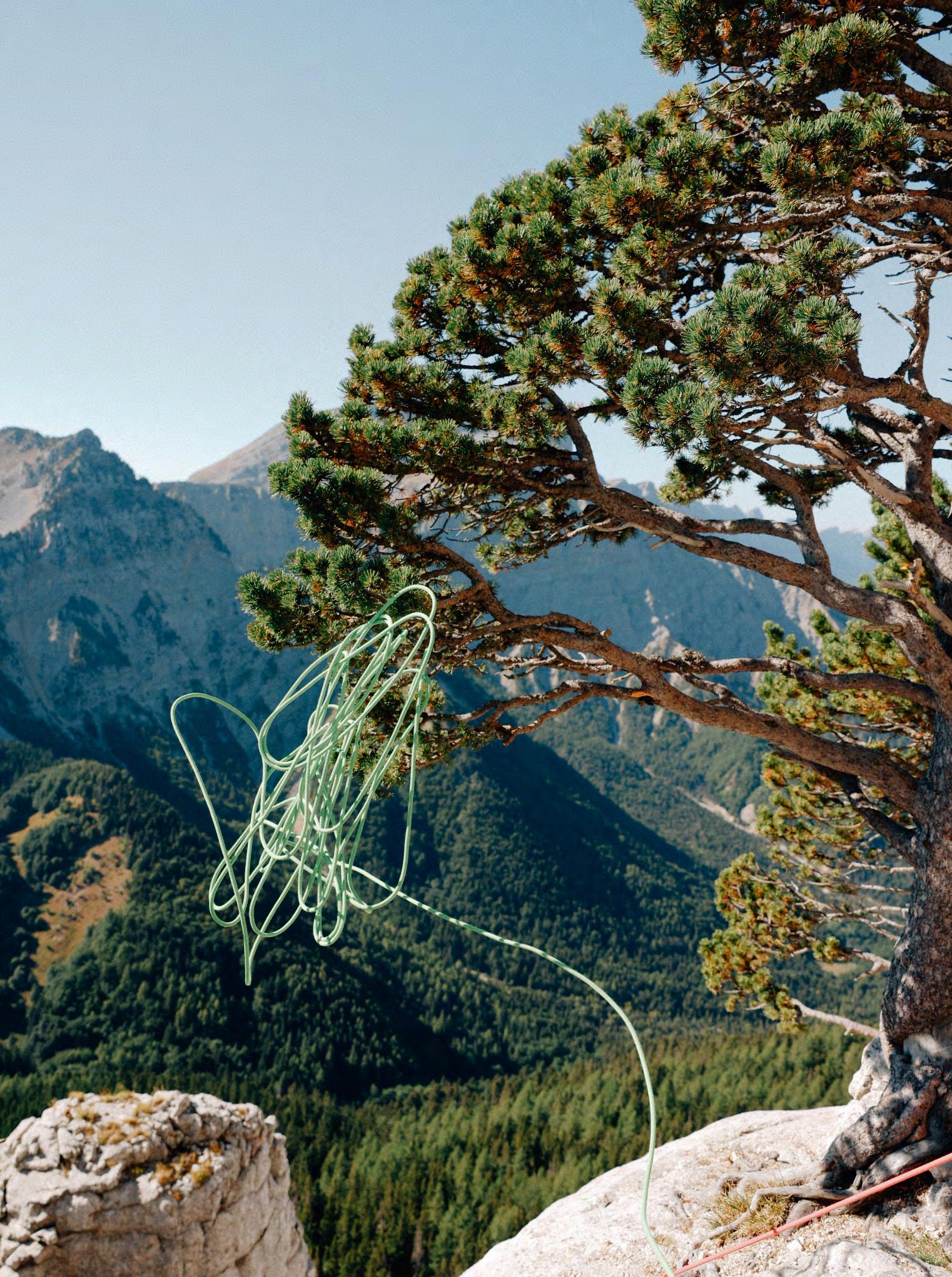
Contents Editors Note [15] A Multi-sport Adventure in the Vercors Mountains [16] Roam to Roam: The Ultimate Guide You’ll Never Need [30] A Field Guide to Hiking the Swiss Alps [38] Micro Adventuring in the Basque Country [52] Of Skin and Rock [68] Rolling Freedom [82] Solo Walking the SWCP [90] Glossary [99]
1
14
What makes us want to document our adventures in the outdoors? Why bring a camera? Does it solidify the existence of the adventure, or is it to produce memories for ourselves, and to share with others? These were some of the questions which I thought about when writing my final year graphic design dissertation on the emerging practice of adventure photography, which is what has inspired this publication.
The concept of Original Freedom is about having fun in the great outdoors, the original playground; to live, play and explore in ways that bring happiness and fulfilment, by focusing on the journey that takes us there. This publication has been developed to share that love of adventure, whether large or small, long or short, remote or local, to inspire more outdoor enthusiasts to venture into the unknown, and seek wilder paths.
Adventure can mean many different things to many different people, Original Freedom aims to reflect this by sharing a wide range of stories, photographs and perspectives. This first issue documents a variety of outdoor adventures, from multi-sport rock climbing trips, to long distance solo hikes, to weekend micro adventures, to escaping the daily 9 to 5 by embracing the commodities of vanlife. So get ready to be inspired to plan your next adventure, journey, ramble, expedition or wandering… original freedom awaits!
Izzy Wedderburn

16
A MULTI-SPORT ADVENTURE IN THE VERCORS MOUNTAINS
STORY & PHOTOGRAPHS: JEAN-BAPTISTE DELORME
In August 2022, I travelled from Bordeaux to Grenoble by train with my bike to meet my friend Damien. We planned a bikepacking loop in the Vercors mountains (French Alps), and since Damien is an experienced rock climber, I had asked him a few weeks before if he could add some climbing into our trip. He was very excited with the idea. We decided to centre the entire adventure around Mont-Aiguille, an iconic mountain near Grenoble known for being a perfect climbing spot for beginners. The route was a mix of roads and mountain bike trails passing through typical villages with beautiful wooden chalets and offering amazing views of the mountains.
The highlight of the adventure was definitely on day three when we woke up at 5 am and packed our gear to head to Mont-Aiguille for our most challenging day. We had to hide out bikes in the forest and hike for two hours to reach the face of the mountain and start climbing from there. It took us the entire day to climb to the top and back down, but the panoramic views from the plateau at the top of the mountain was the reward, a truly unforgettable memory.


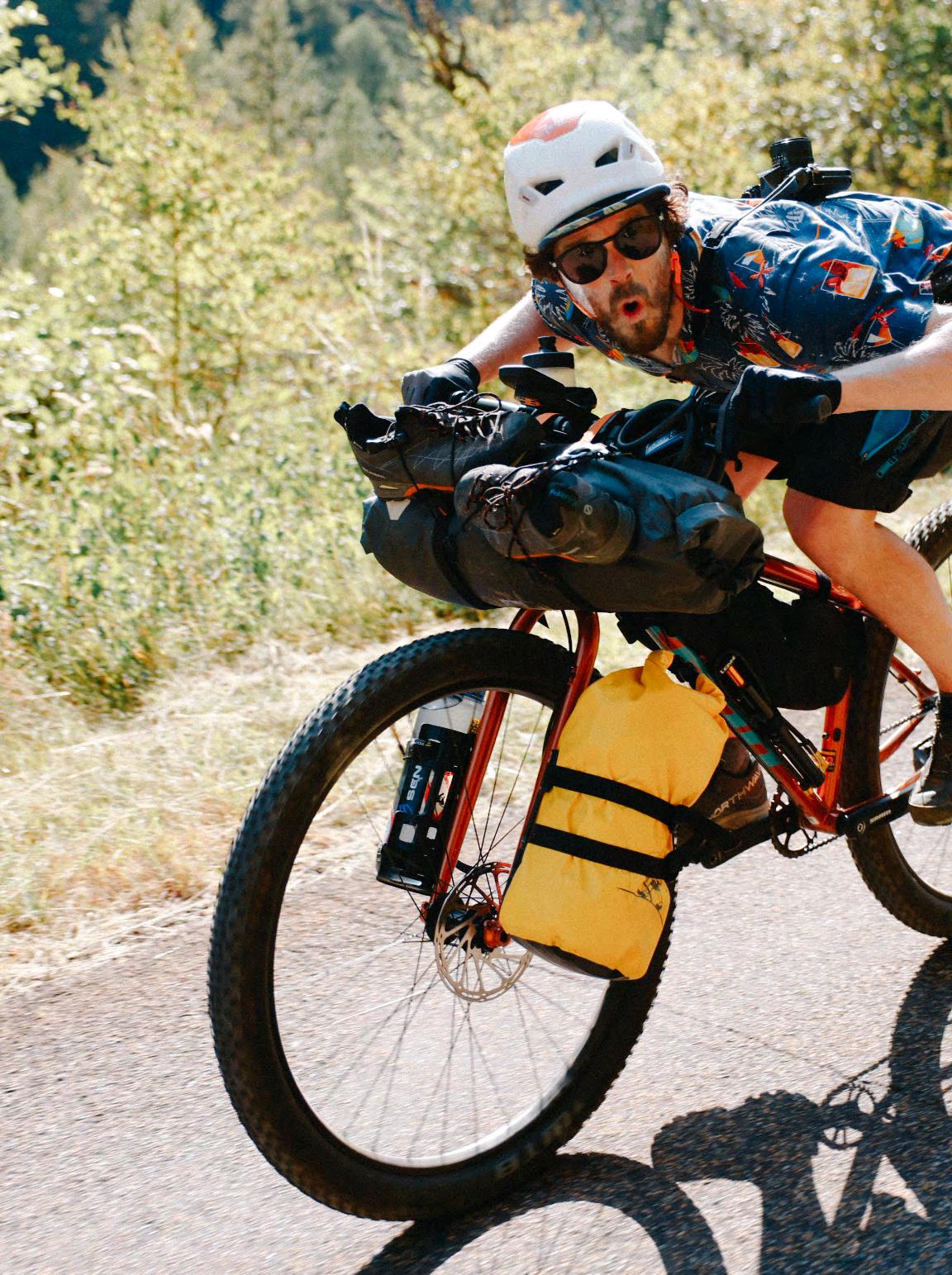

21

22 22




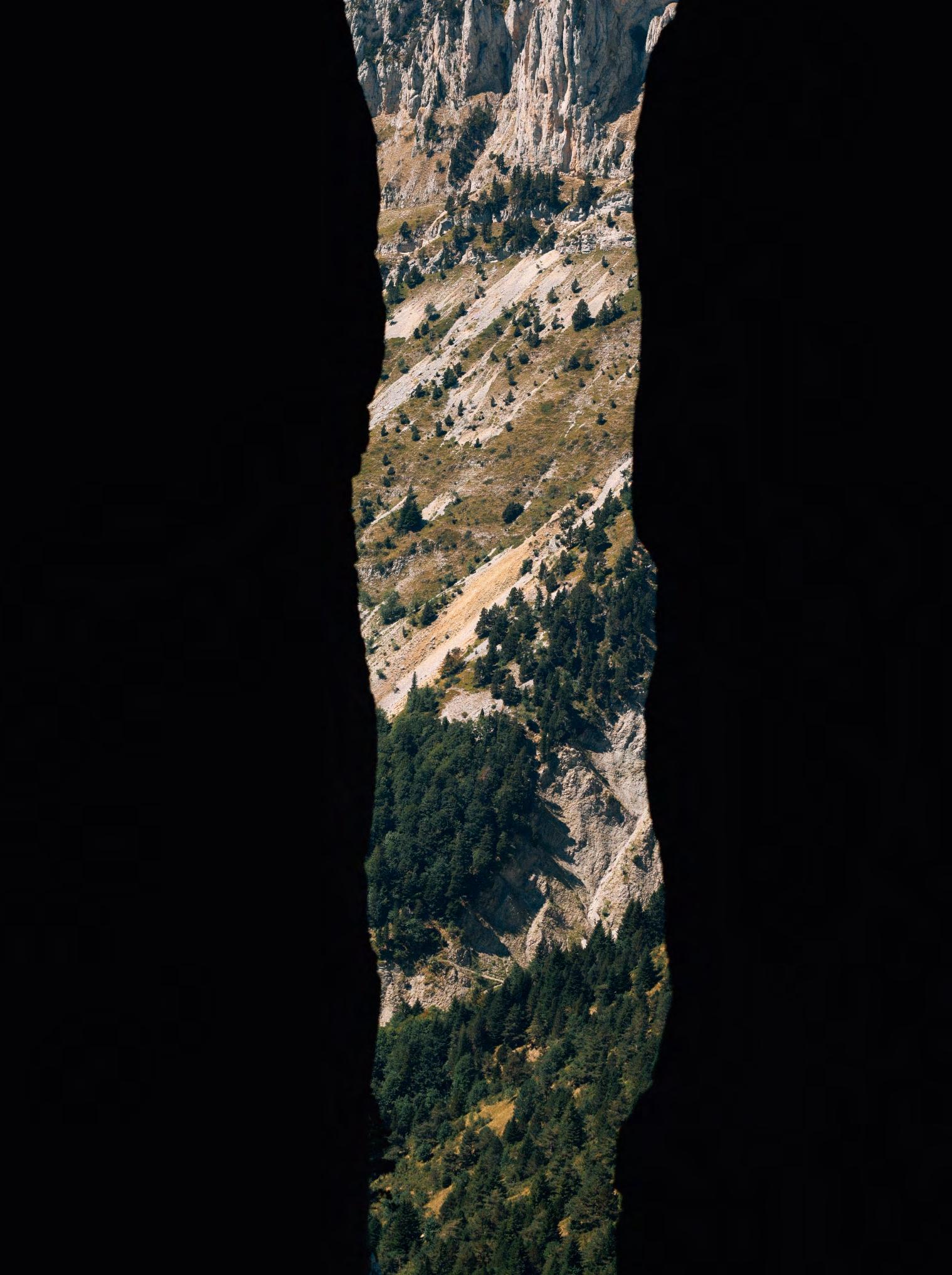
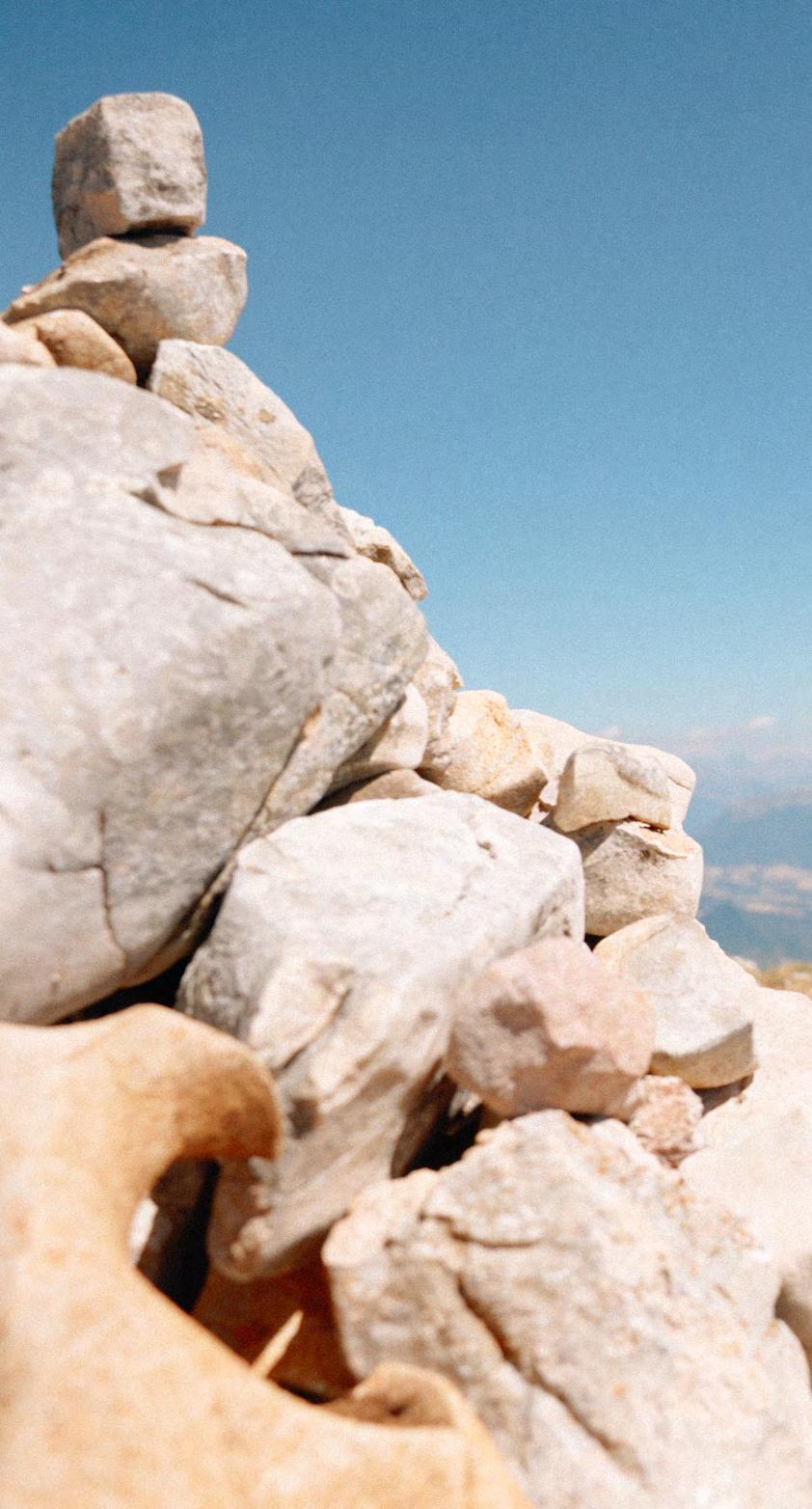
28

44.8420° N
5.5530° E
ROAM TO ROAM: THE ULTIMATE GUIDE YOU’LL NEVER NEED
What is Roam to Roam?
We are Roam to Roam, a Bristol based design duo made up of photographer Alice Poole and illustrator Rosie Yates. Working together we have created Roam to Roam as a way of combining our artistic practices, blending both analogue and digital methods of image making. We wanted to create work that challenges new methods of making and celebrates the beauty of the outdoors in a totally creative way.
Where did the idea of Roam to Roam develop from?
Roam to Roam began outdoors, after many long walks and discussions on how to navigate our own careers within the creative industries as young female creatives (and the challenges that come with this). We decided it was time to make something that we felt was missing. We wanted to use Roam to Roam as a snippet of escapism for both us and the viewers.
Inspired by themes of nature and the outdoors we want our work to act as an alternative and creative perspective on destination spots around the UK. Roam to Roam has also been a fantastic creative challenge for the both of us. It is a way of having accountability to make new work together, and to try out different ideas that go beyond our individual creative practices.

Interview with the creative duo behind Roam to Roam

Illustrations, Photographs and Text
by Alice Poole & Rosie Yates
31
@roamtoroam_
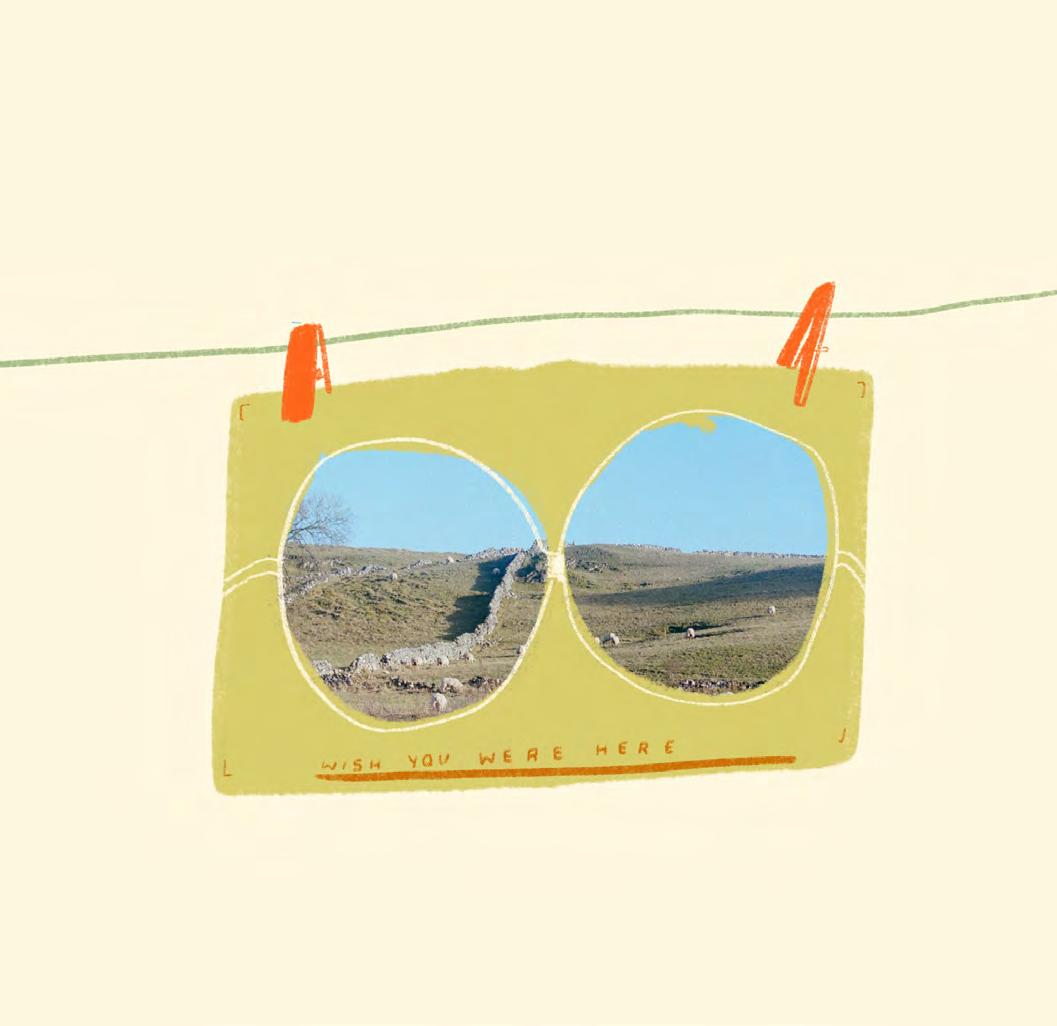
What are your methods as creative partners in producing work for Roam to Roam?
Lots of our work together as Roam to Roam is done remotely, at times we haven’t always lived close to each other so have relied on regular Zoom calls and lots of Milanote boards—a great resource for anyone else wanting to work collaboratively.
However, now after a bit of trial and error we have figured out a process that works for us. Out on location we will go together, Alice armed with her cameras (she shoots on film) and Rosie with her sketchbook. Whilst there we are scouting out the place, making notes and hoping
the photos come out clearly. We then wait for the film to be developed and in this time we do lots of collaborative research together putting together boards with inspiration on (artists, films, books, colour palettes, articles) before we begin making.
Once the film is ready and edited by Alice we will select our favourite few and start with initial ideas and a general theme for the work. All of this is done digitally with lots of WeTransferring of files.
Rosie will then use Procreate to draw over the photos, looking back at references made on location and taking influence from all of the images. New ideas come as we begin making so sometimes the work evolves a lot, but our main aim is to make work that is creative, innovative, and challenges new ways of making.
Collaborating our practices is really refreshing for the both of us, it allows us to gather new references and use each other’s work as a source of inspiration. Working both digitally and with analogue film has really allowed us to try and replicate the handmade through more digital ways of making, and to draw inspiration from both the past and present. We love working together and find that this process has enriched our own practices separately too.
32

Has developing Roam to Roam changed your outlook on what you think of as an adventure? If so, how?
We think the term adventure applies to all aspects of Roam to Roam, which we didn’t quite expect before working together. Setting off to new places with our sketchbook and camera, we’re never quite sure what we might end up with at the end of it, which in itself is an adventure!
Adventure is waiting for the film to develop, looking through drawings made on location and getting excited about what new work we can make. Working collaboratively also means that we’ve got two sets of eyes seeing
things in different ways whilst exploring the outdoors. Bringing these together in visual form has also been an adventure for both of us.
The idea of adventure could also be applied to our own careers and where we both are creatively. We began Roam to Roam as we both felt a bit lost within the industry, not knowing quite where to place ourselves or how to find opportunities. This is something we are both very much figuring out as young creatives, however Roam to Roam has helped give us purpose and a focused sense of direction. Being part of a creative duo also means that we can support each other on our own adventures, and talk through all our creative woes on every adventure we go on.
What is the most exciting or memorable adventure you have been on together, and why?
We’ve had a few with Roam to Roam! On our most recent location trip we headed to Durdle Door and Lulworth Cove in Dorset. A truly stunning spot, we spent the day walking along the coast path and having plenty of ice cream stops.
On our way home which was a two hour drive back to Bristol the exhaust on Alice’s car fell off! Which proceeded to be a few
33

34
hours of sitting on a plastic bag on the side of a ditch in the dark and rain waiting for the RAC to arrive. With 1% phone battery it was touch and go, but after several hours of waiting we were finally rescued (luckily we were only stuck about 20 minutes from home).
Aside from car drama, we’ve had the opportunity to see the stunning landscapes on offer in Dungeness. We visited this wild-west-like landscape in April 2023. The sky was a piercing blue and it honestly felt like we were on another planet. It gave us so much rich visual inspiration and really is like nowhere we’ve ever been before!
Setting off to new places with our sketchbook and camera, we’re never quite sure what we might end up with at the end of it” “
Where do you get your outdoor inspiration from?
We get our outdoor inspiration from lots of different sources. Sometimes it could be a location linked to an artist that we are interested in, such as Dungeness which is the home of filmmaker Derek Jarman. Other places we have visited have been locations that we are familiar with and have explored the landscapes before, like the rolling hills of the Peak District or vast cliffs of the Jurassic Coast.
In some ways when we are thinking about a new location we are also considering what might look fresh and interesting in our work, to see how we can explore a variety of landscapes in a different way that is new for our viewers.
Whilst out on location we will also take time to research any local history or points of interest, to see if we can weave this back into an imaginative way of telling a story about a place in our work. This could be through coordinate points, sign posts or place names—we love looking at place names, they can be really interesting and sometimes provide an opportunity for a play on words!
35
Just being outside in nature is the best way to get inspired and gain confidence in where to explore next”
What would you say to someone wanting to get into the outdoors, but didn’t know where to start?
The outdoors doesn’t have to be an expedition with all the gear, it can simply be making a flask of hot tea and heading out for a walk in your local park. When we began Roam to Roam we kept it very local and just followed footpaths on our doorstep. We usually had no idea where we were going but always made sure to have a rucksack full of snacks, our sketchbooks and a camera.
It can feel quite daunting knowing where to start with the outdoors, but the best part of it all is that it’s free and you don’t have to go far to begin with. Just being outside in nature is the best way to get inspired and gain confidence in where to explore next. As friends as well as a creative duo we love to just get outside and chat as we go, it allows us to think clearly and see the path ahead—both literally and figuratively!
What is the future of Roam to Roam?
We hope that we can continue making and expanding our methods of creating with each location that we visit. At the moment Roam to Roam exists very much in an online format and we make our work digitally to fit this. For the future we hope to produce something physical and hopefully achieve our aim of creating travel zines that are interesting, creative and accessible to everyone. We would love to work with people more and focus on specific industries, as well as expanding on the story-telling elements of Roam to Roam.
We also really enjoy writing our bi-weekly newsletter ‘Mooch’ which is another really rich source of inspiration for us. We will be continuing with this into 2024. We love making work collaboratively so it’s exciting to think what the possibilities for new work might be!
36
“
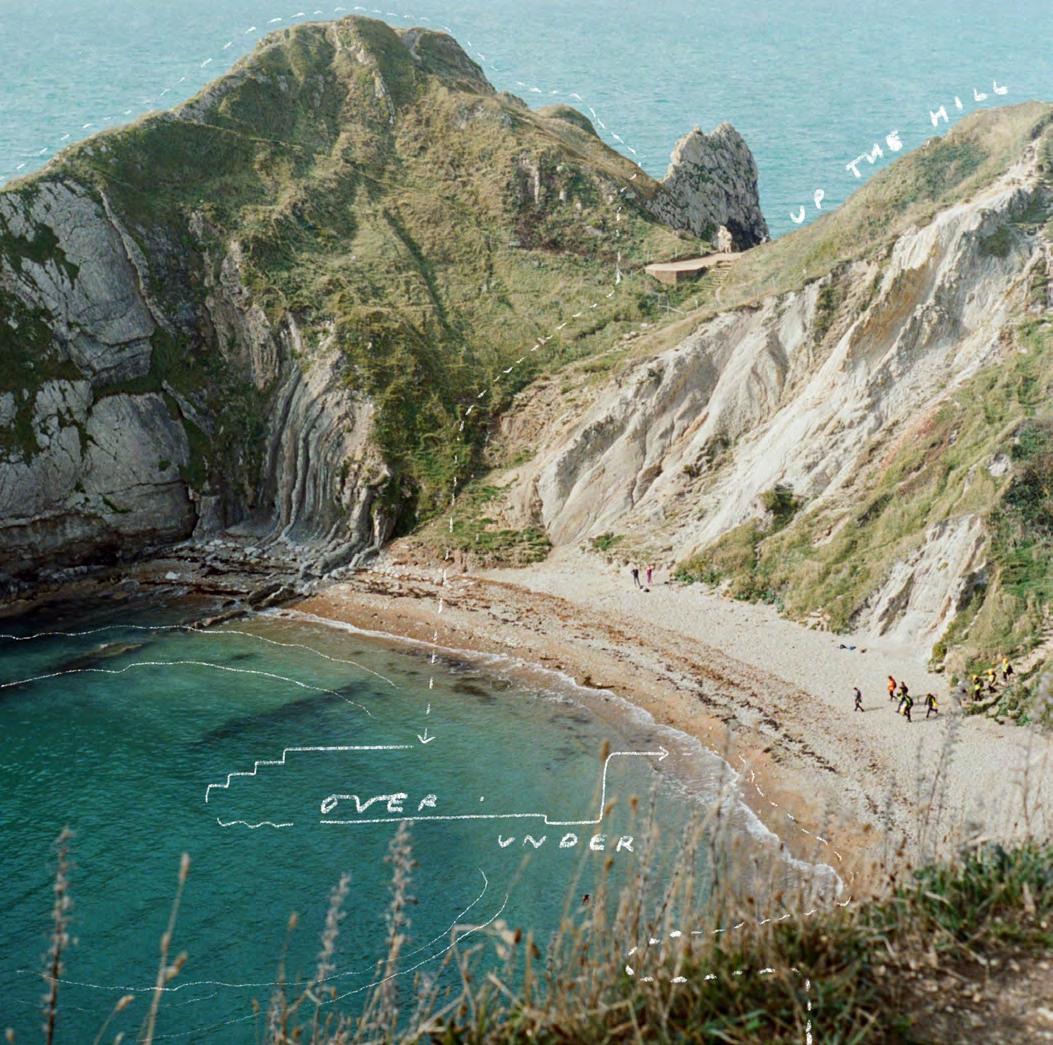

37
Story & Photographs:
Izzy Wedderburn

38
A Field Guide to Hiking the Swiss Alps
The Swiss Alps is an absolute paradise for walkers and hikers of all levels, which is often less busy than neighbouring France. The mountains offer some of the best and most extensive hiking trails in the world at 65,000km of waymarked paths, and over 150 refuges. The hiking season begins in May and finishes at the end of September, (the busiest and hottest time is between July and August). Go in spring to catch the flourishing alpine flowers and some left over crunchy snow, or in autumn for cooler temperatures and colourful foliage.


40

In the July of 2023 I joined a group of enthusiastic hikers on a three day circular hike in the canton of Valais, near Zermatt in Switzerland. We began in the small quaint village of Randa and quickly gained height to reach the Europahütte, a well-known refuge on the famous Europa Trail. Beers, minestrone soup, and hot stew were a delicious reward after a long day of travelling, and fuelled us up for the next proper day of hiking.
41

We woke to a friendly ibex chilling outside the hut, licking the alpine rocks due to their high salt content. A classic Swiss breakfast of muesli and solid German bread boosted our energy levels for the day ahead.
First up was the famous Charles Kuonen suspension footbridge which up until recently was the longest pedestrian suspension bridge in the world (I think there is now a longer one in the Czech Republic), which provided nearly half a kilometre of air beneath our feet. The slight bounce was quite unnerving at first, but we soon got used to it by focusing on the beautiful panoramic glacial views instead.
We then left the Europa Trail and began following the Edelweiss Trail (yes like from the Sound of Music!) to Täschhütte which had breathtaking views over the valley at 2700m. We had a chilly night, but luckily the hut gave out free minty raspberry like tea to keep us warm and toasty.
42

The next final day was to be the longest day at 20km (+1000m / -2000m). We clambered along the Tashalp Path, and traversed up to onto Pfulwe Pass to reach the summit of Pfulwe (3313m), where we had the most epic views of the Monte Rosa Massif, and finally got to see the wonder that is the Matterhorn. The hike back down into Zermatt wasn’t kind to the knees, but the sun was shining and an obligatorily strudel stop was made, which did not disappoint!


44
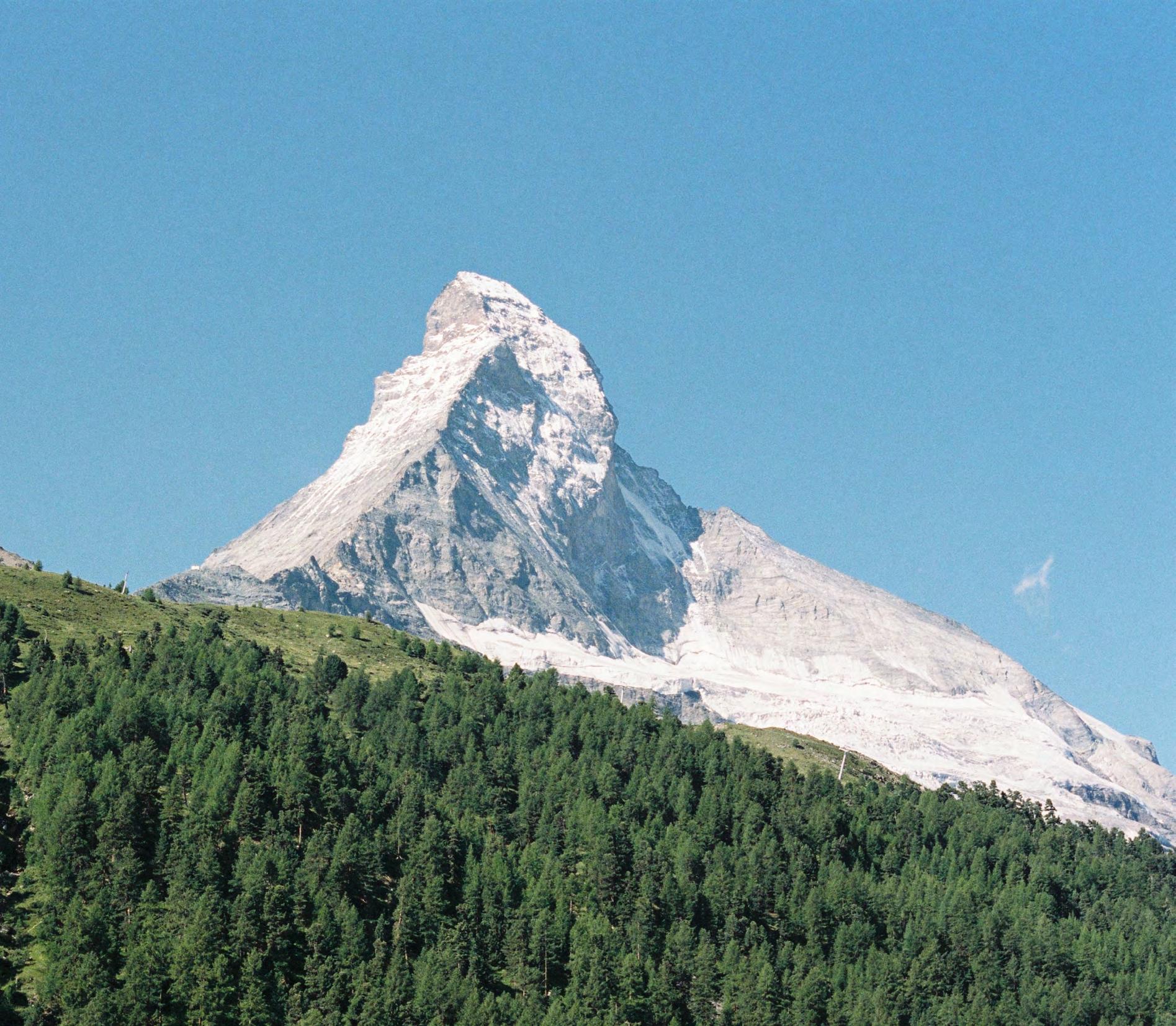
45
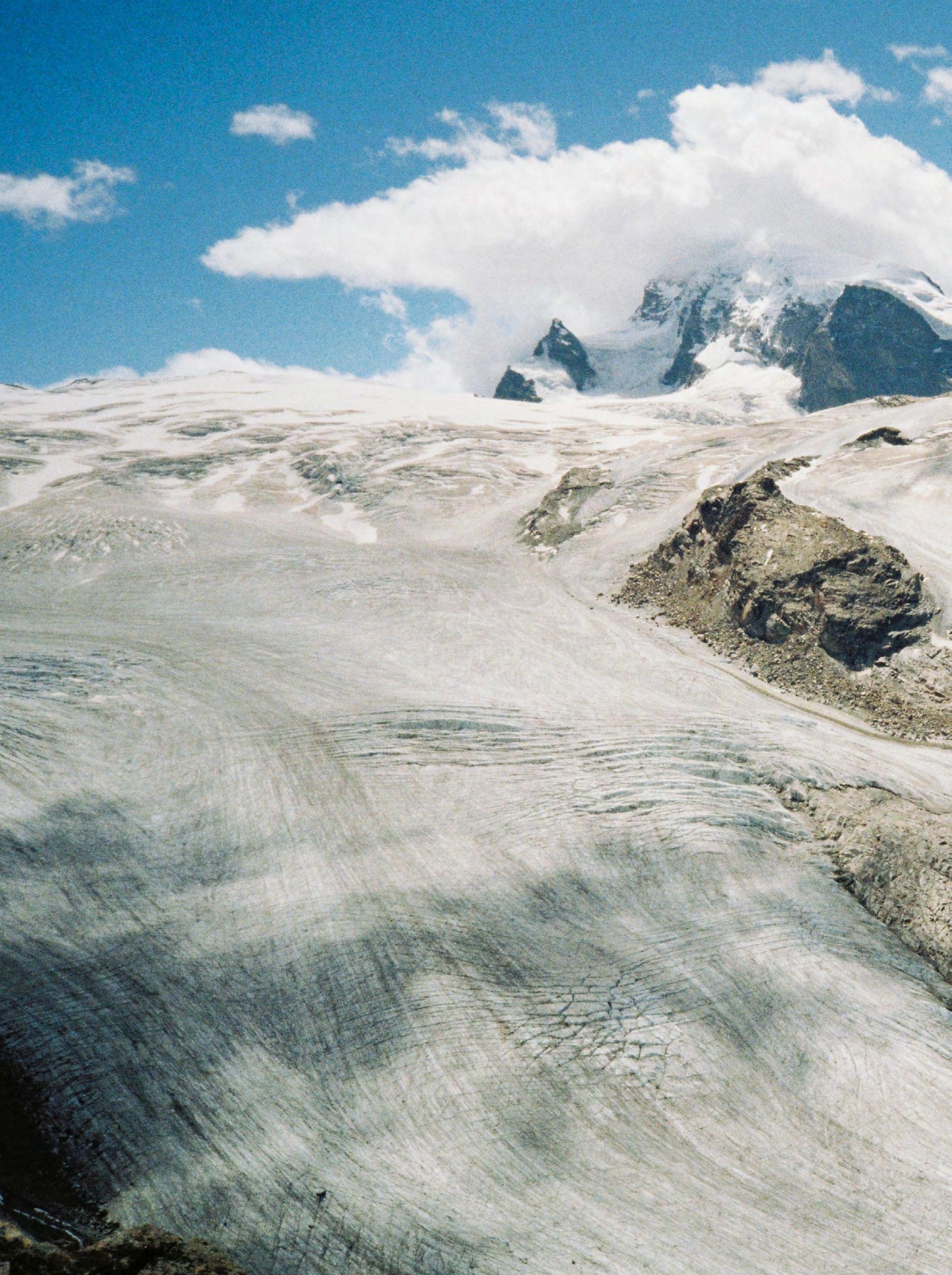

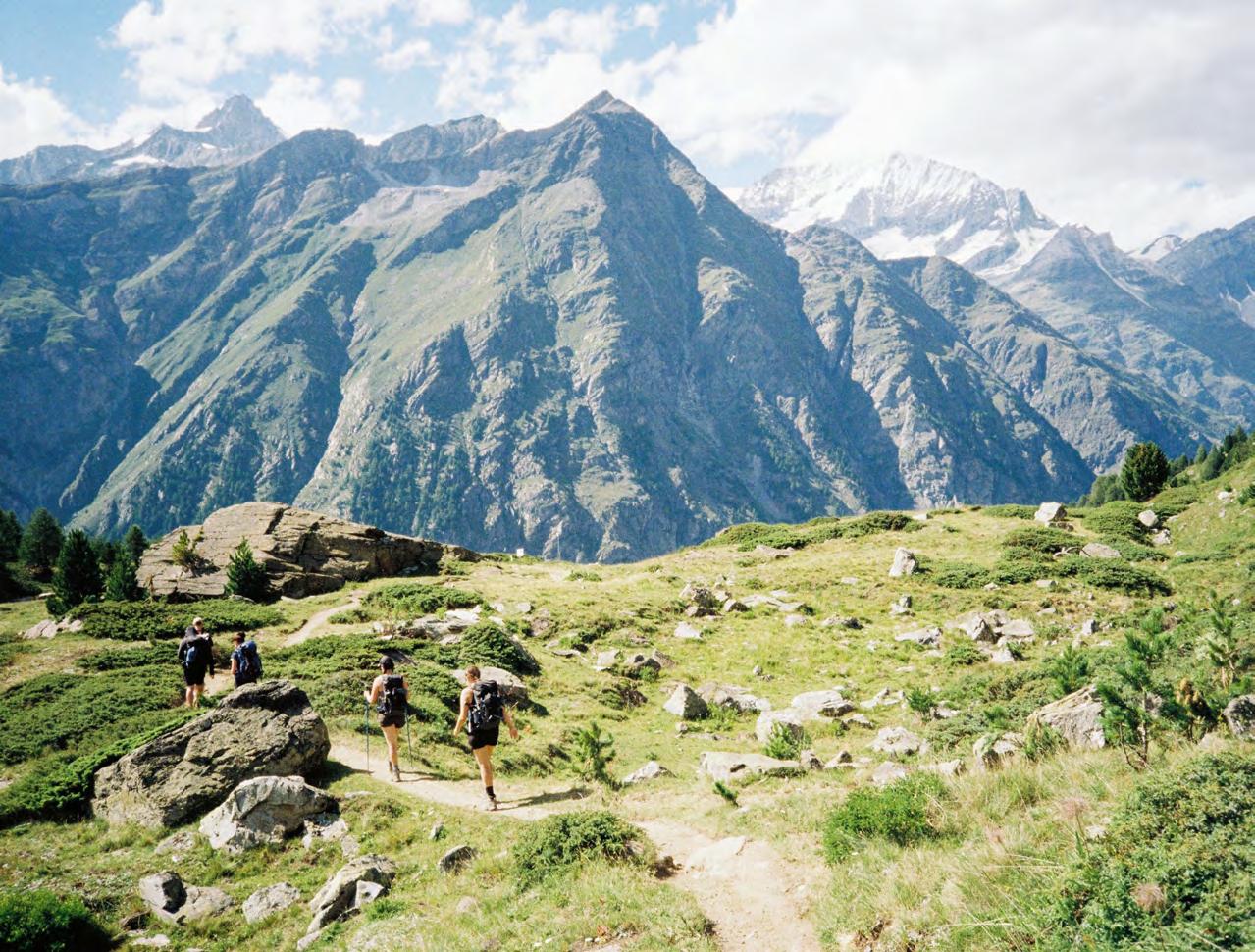
Walking further down into the resort, we were reintroduced into civilisation; people, bikes, electric cars, artificial noises and tarmac! It was a funny feeling as for the past two and a half days all we had seen and heard were other hikers, and the occasional marmot. I felt a huge connection to the environment which I had been in; I didn’t want to re-join ‘real’ life again.
Hiking in the mountains made me forget about all my worries, resetting back to my default self. I only took an analogue camera for this reason; no worrying about settings, memory card storage, or battery charge. The camera and the film did all the magic for me, enabling me to be in the moment amongst the mountains.
48
At the end of the final day we reached the centre of Zermatt, where we stocked up on a selection of Swiss goodies and admired the magnificent valley of mountains and glaciers for the last time before hopping on the short train ride back to Randa (which ironically took only 15 minutes!). I sat on the crowded train with a pair of swollen blistered feet, a bag full of used up film, a bunch of new hiking friends, and a large grin across my face from a wholesome few days of re-connecting with nature, and the outdoors.

49
5 miscellaneous things to know when hiking in the Swiss Alps:
Be smart on water, if high up use fresh glacial water to refill your water bottles and bladders. The Swiss mountain huts often make you pay for tap water, and bottled will break your bank account! 01 02 03 04 05
Look out for ibex, chamois and marmots, these furry friends can be seen all over the mountainside, so get your binoculars ready!
In Switzerland, each region or county is called a canton. The Swiss speak French, Italian, Swiss German and Romansh, so check to see which language is spoken in the canton you are visiting.
Some traditional Swiss delicacies include raclette, fondue, rösti, and of course Swiss chocolate.
The Swiss Alps has an extensive mountain hut system, where you can stop, have a coffee and a strudel, or stay overnight in a mixed dorm (recommended to book online first). Always remember your sleeping bag liner, as it is a requirement for all huts.

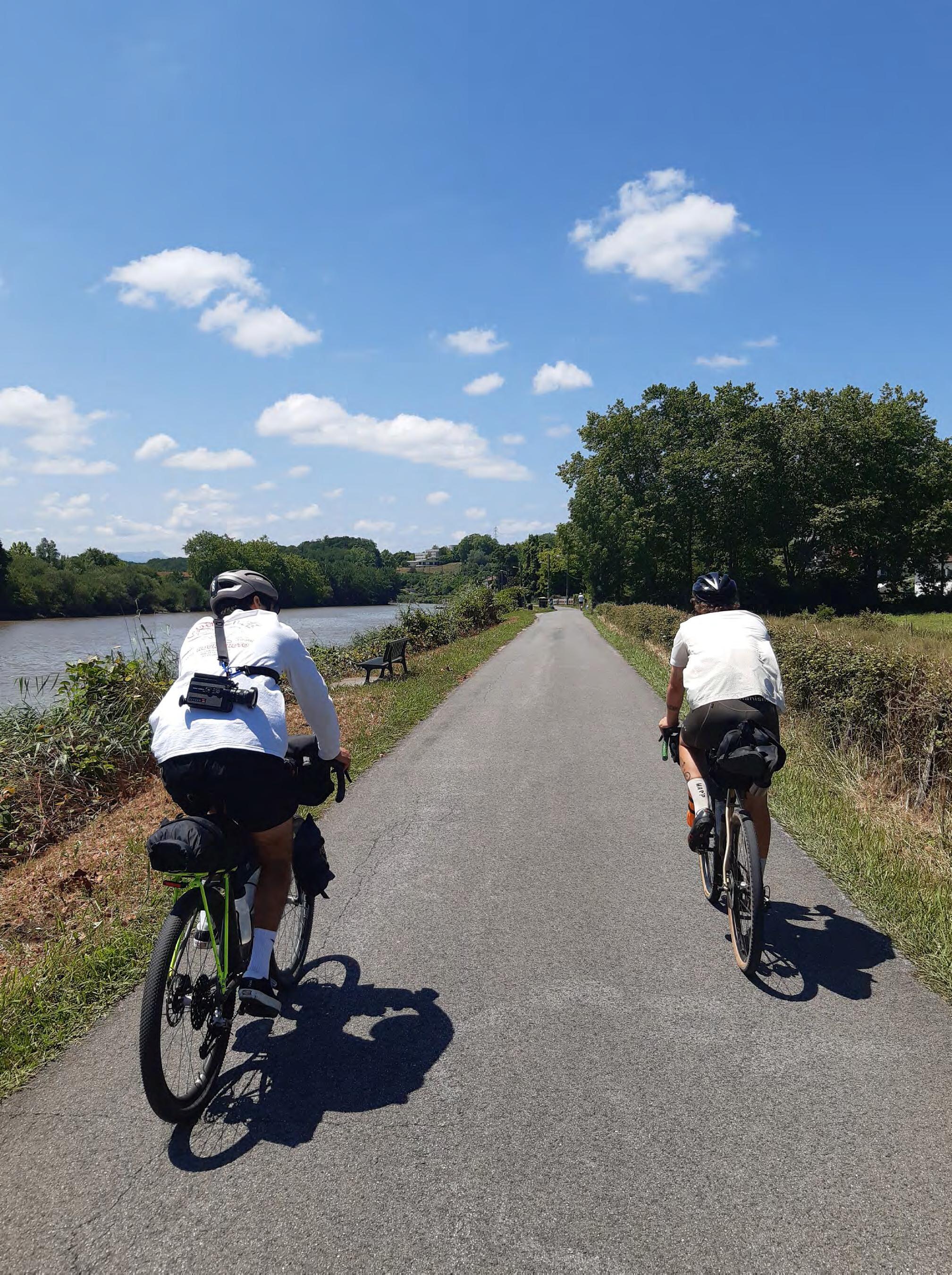 Story & Photographs: Juliette Charpentier
Illustrations: Izzy Wedderburn
Story & Photographs: Juliette Charpentier
Illustrations: Izzy Wedderburn
In July 2023, three friends decided to take an impromptu bikepacking trip to the French Basque Country. They had no plan, no map, and no checkpoints. Their only aim was to have fun riding bikes and enjoy eating local delicious food.
53
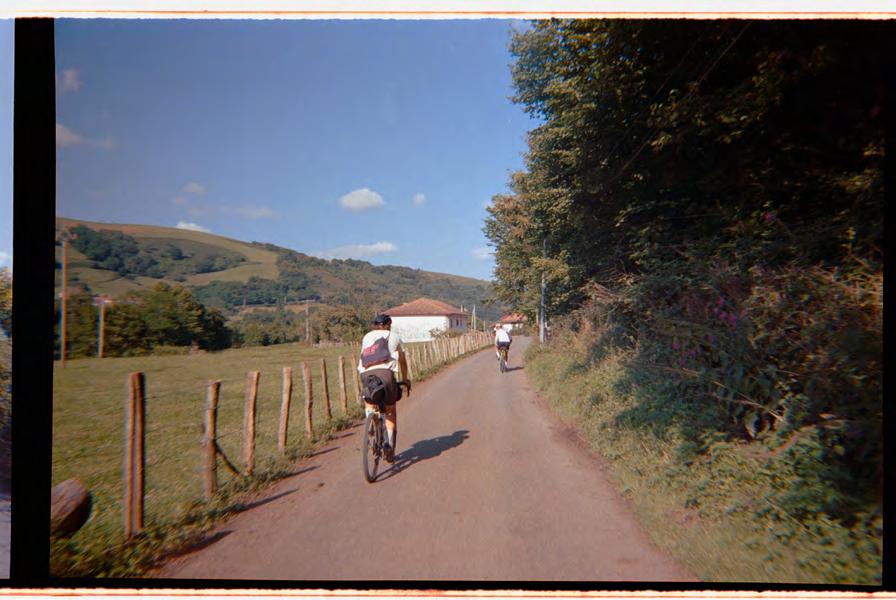
We didn’t plan anything for our first bikepacking trip together, Enzo, JB and I. The plan was to do a short trip, eat local good food, meet interesting people, and have fun on our bikes.
54

55

56

Enzo came from Montpellier to meet us in Bordeaux, and we then all took the train with our bikes packed with all our stuff to have a comfortable bikepacking trip to Bayonne in the Basque Country. I even brought a night lantern and a bouquet of flowers to have fancy dinner picnics in the evening!

57
We clearly ate more than we rode, but it was so fun because we were just guided by the next food stop, taking time to take photos of sheep, butterflies and beautiful landscapes. JB brought his super 8 analogue film camera and stopped each time we met a new animal—he almost fell in love with a dragonfly, I think he used up more film on it than the rest of us!

58

59
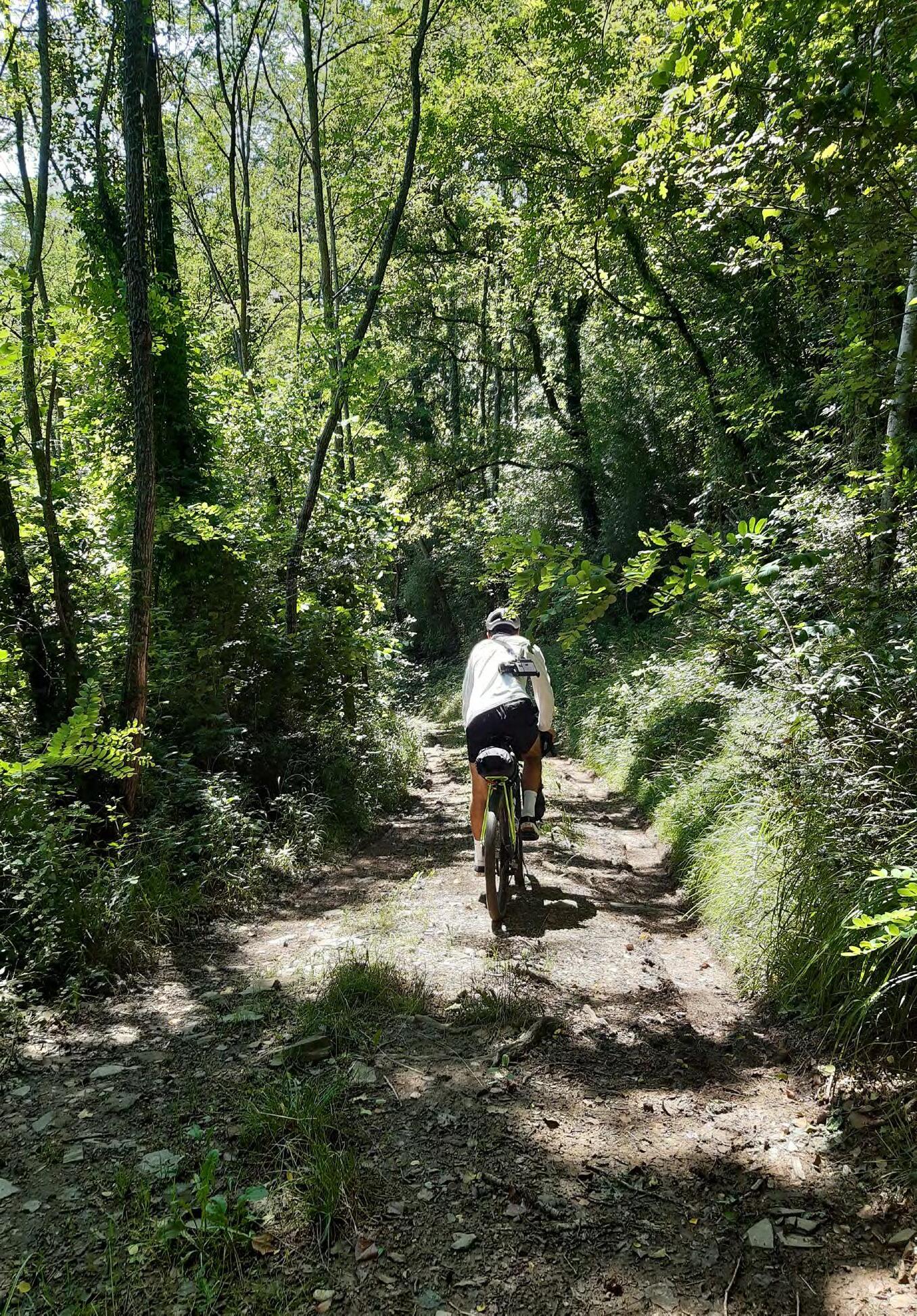
60

It really was a pure adventure because we had no map or checkpoint—except Biarritz where we had to take the train back home. We were only guided by what seemed interesting, good to eat, cool to see, and fun to ride. This is the magic of bikepacking, no performance just fun! We perfectly embraced this mantra throughout the trip.
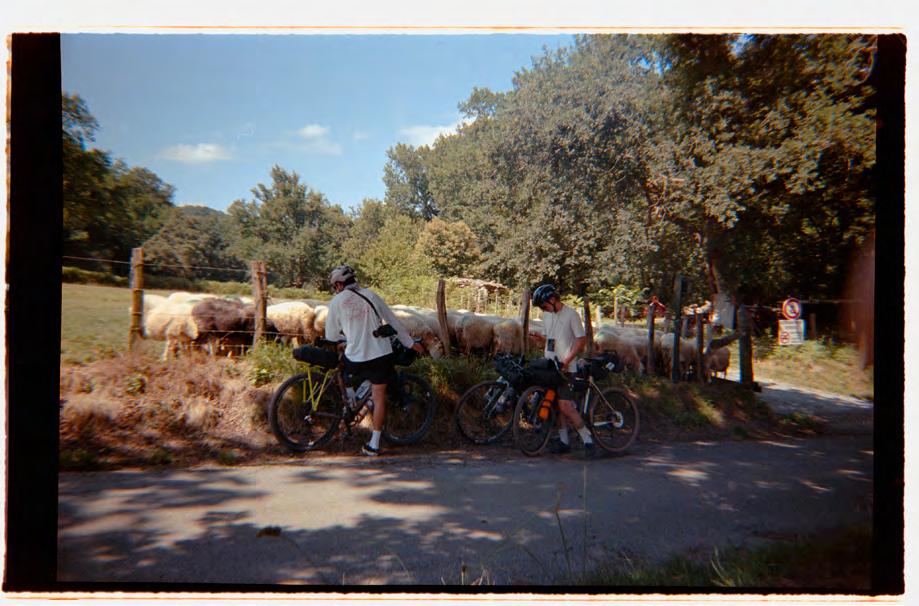
61
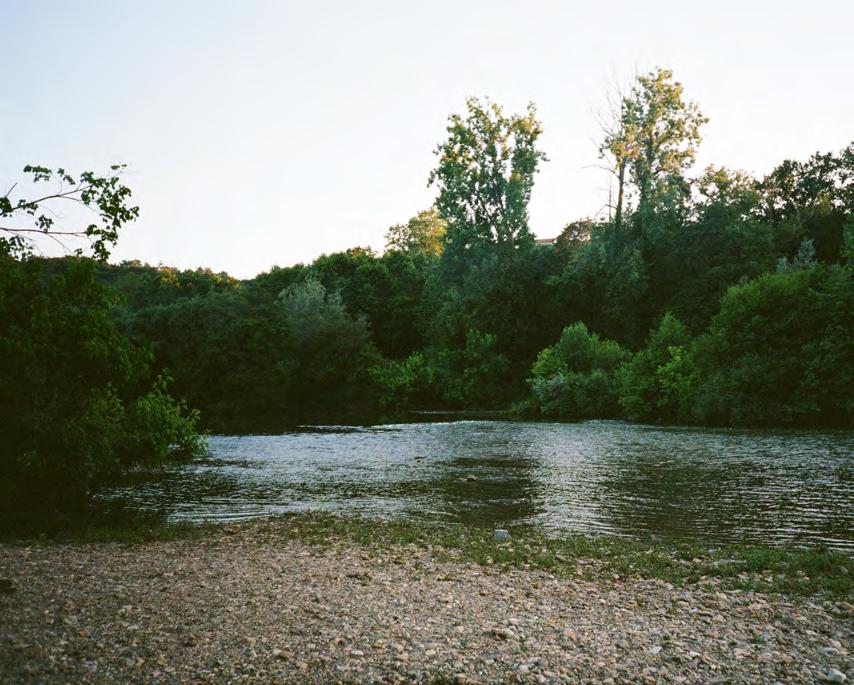
Our last night was very idyllic, we put up camp next to a calm river with small pebbles and big overhanging trees in the small village of Ustaritz. Izzy came from Biarritz on her little red Vespa to meet us at the riverbank. We drank cold beer while wading in the cool river, and enjoyed a simple delicious picnic between friends, sharing our enthusiasm of being here together on a summer evening.
62


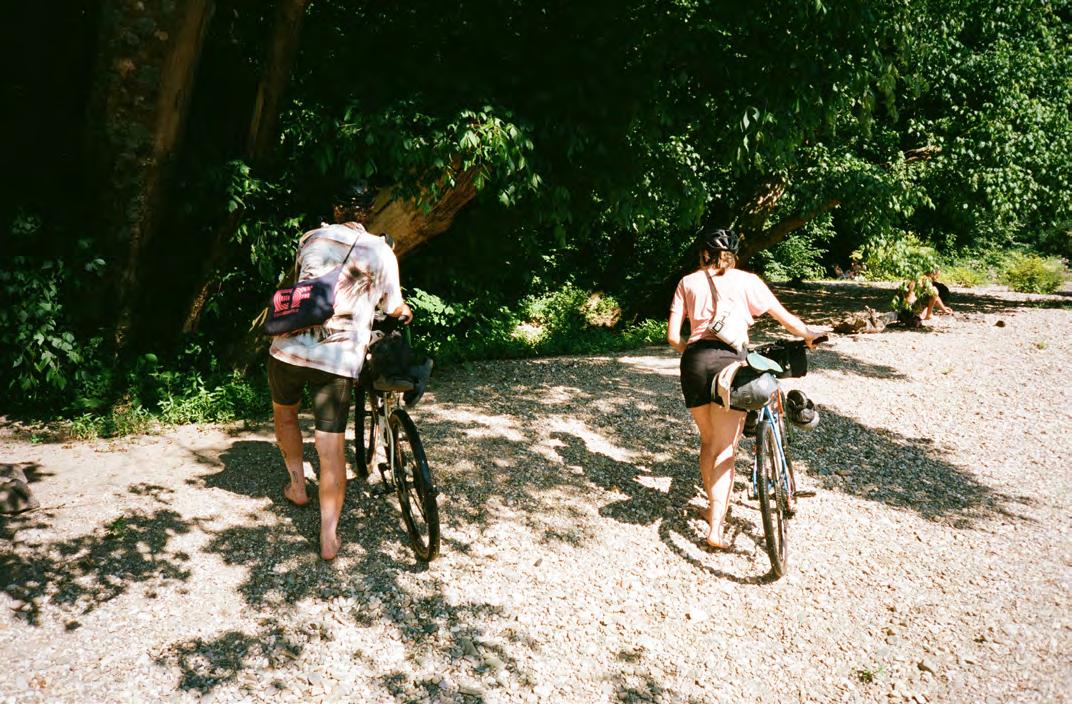


63


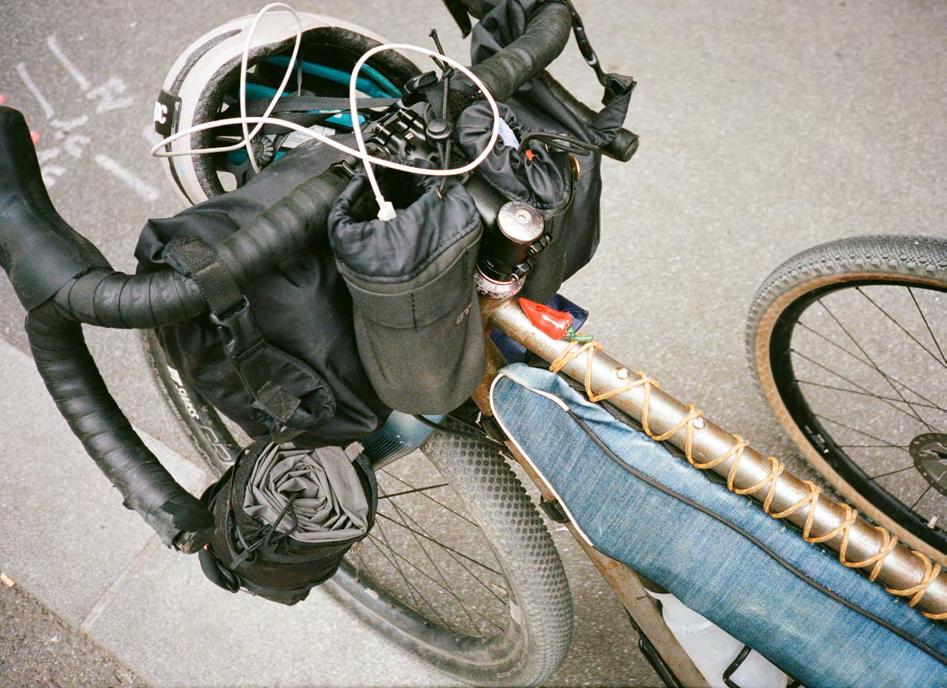


64


The bikepacking trip finished with an afternoon sightseeing in Biarritz, following Izzy around the cool spots of the city, whilst eating the best gelato in town.
Enzo bought each of us a cheap magnet in the shape of an Espelette pepper to remember this moment of friendship and bikepacking adventures together. An epic and happy ending.
65

66
What we ate during the trip:
67

68

Of Skin And ROck
Large Format Photography, Words & Interviews by Fin
MacMillan
In an age where so many hobbies and sports are incredibly accessible, why do we choose to climb? Why travel so far along rugged terrain with heavy bags to scale cliff-tops or mammoth boulders, destroying our hands in the process and, eventually, injuring ourselves. This question of why is one that I kept finding myself coming back to.
As a climber and a photographer, I was in a unique position to explore this through the lens, and so I spent close to a year walking out onto the boulder-fields with my 45kg kit, sleeping under boulders or in pillboxes, and climbing as much as I possibly could. Bouldering has always been a big part of my life, but it feels as though I have uncovered a far deeper and intimate side to it over the past year and during the production of this project—and the experience has been utterly amazing.
These images were taken on a particularly cold December night in 2022, climbing until midnight in -1 degrees before dragging our pads under Vandal Boulder to sleep. There was a beauty in this lifestyle once it had been fully embraced and I would frequently long to be carrying the weight on my back while walking to the train with a mind full of the adventure I was going on.
70

71

Fraser Long
When you combine sport, adventure, and problem solving, you get bouldering. One cannot compare bouldering and climbing, as one does not compare oranges and apples. Bouldering demands the absolute physical limits of the persons involved, with the addition of perfect coordination and raw strength. This is what attracts me to bouldering and keeps me returning to Portland (Dorset) at the weekends despite the shredded hands, numb feet, and treacherous approaches. It takes a certain type of someone to actually want to put themselves through pain and suffering on their only days off each week.
There is this undeniable sense of satisfaction when you finally unlock the beta for a boulder problem, and even more so when those intricate moves on the rock are achieved and you finally top out the boulder. Friends for life are born when you explore the boulder fields and stand next to a boulder in the blistering wind, where you and fellow dirtbags encourage each other to send that project! The bouldering, and even climbing community is like no other. There is no prejudice, judgement, or competition, but more of a bunch of like-minded individuals who share a love for… well… rocks!
Bouldering isn’t a sport, it’s a lifestyle. A lifestyle I have been completely engrossed in since I first grasped those plastics holds nearly 3 years ago. That is why I choose to boulder.
Fraser under Sunbathers Slab

one cannot compare bouldering and climbing, as one does not compare oranges and apples
73
Fin MacMillan
Ross was another one of those amazing people that came to me through climbing. Selfless, kind, and with an absolute passion for the sport. This was our third climb together along with Fraser; it was a cold, dark winters night and we were out to climb something hard. Distant walkers would have spotted three small figures huddled under Terrace Boulder—headtorches illuminating the condensation of our breath.
These trips form strong bonds, perhaps it’s the vulnerability? The bare-chests and physical limits pushed. Or maybe it’s just the time you spend with often like-minded people. A couple of weeks after that night, Ross fell during a session and tore his bicep away from his shoulder, resulting in surgery and a long journey of recovery. Weeks later I could see that Portland was still calling him, a hole had been created.
I met Tom in Portland, he had been one of those anonymous faces at the Project climbing gym and, at first, I felt some trepidation towards me. As per usual, I had my large format camera and portable flash heads which stuck out like a sore thumb in the Cutting’s landscape.
We climbed all morning and then, in a personal first, I saw Tom slide a cigarette out of a Honeyrose box and light it up. He said the falling ash burning his skin gave him an adrenalin rush, forcing him to climb harder.
After he saw me complete some tricky climbs, his demeanour towards me changed. He no longer saw me as an outsider, I was a part of the us, and I was able to take his portrait.

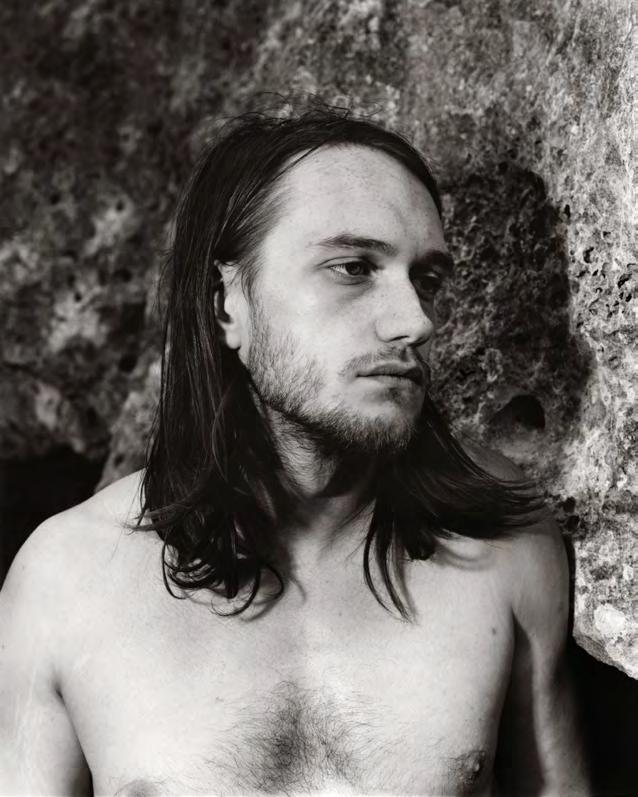
74
Ross under Terrace
Boulder
Tom under Lip
Boulder

distant walkers would have spotted three small figures huddled under Terrace Boulder—headtorches illuminating the condensation of our breath
75

Josh Lightfoot
Why do you boulder?
The quick answer is, because I enjoy it! This doesn’t satisfy everyone.
Let’s rephrase the question, what motivates you to boulder? Also, an easy one to answer. There are many factors; getting stronger; finishing a project, or simply spending time with friends, to name a few. These extrinsic motivations drive us every day.
What if you were to take those away?
Imagine a cold January day on the Dorset coast. A crisp northerly wind is blowing. My numb fingerprint-less digits are flicking through the tatty pages of my guidebook. I sit on my mat looking up at a limestone boulder the size of a small minibus. There are no new routes for me to try here, but I am here, nonetheless. With the nearest soul over a mile away, perhaps a fly on the wall would consider my original question.
Why do you boulder?
What you have left are your intrinsic motivations. It’s that inherent pleasure without need for reward that makes it special and keeps me coming back; hopefully, for many more years to come.


getting stronger; finishing a project, or simply spending time with friends
77
Josh under Agglestone
Fin Slip Lip, Lip Start
Harry Sheppard
Climbing makes me feel like a kid again. Always striving for the most challenging thing to climb, but with structure this time, and a sense that incremental progressions are improving so many aspects in my life. It is a culmination of three of the most important health focuses, the social, the mental and the physical, and since starting to climb I have yet to feel the same sense of satisfaction and challenge that you get from climbing.
I have been climbing less than a year but can already see that the foundations have been set for this to be a hobby and lifestyle of mine for the rest of my life, with the contagious nature already spreading around my social circle and becoming a healthy change to the lives of myself and the people around me.
As someone who used to be an avid gym goer with the mentally exhausting goal of a certain body shape, to now somebody who wants the climbing strength regardless of the look that is complemented with it, climbing has become a mentally invigorating addiction, where the only mental set back is the disappointment when you can’t get yourself to a climbing gym or the great outdoors.
Climbing is here to stay in my life, and I hope to spread the climbing bug on to whomever I can, in the hope that they find the same social, mental and physical benefits that I have done.
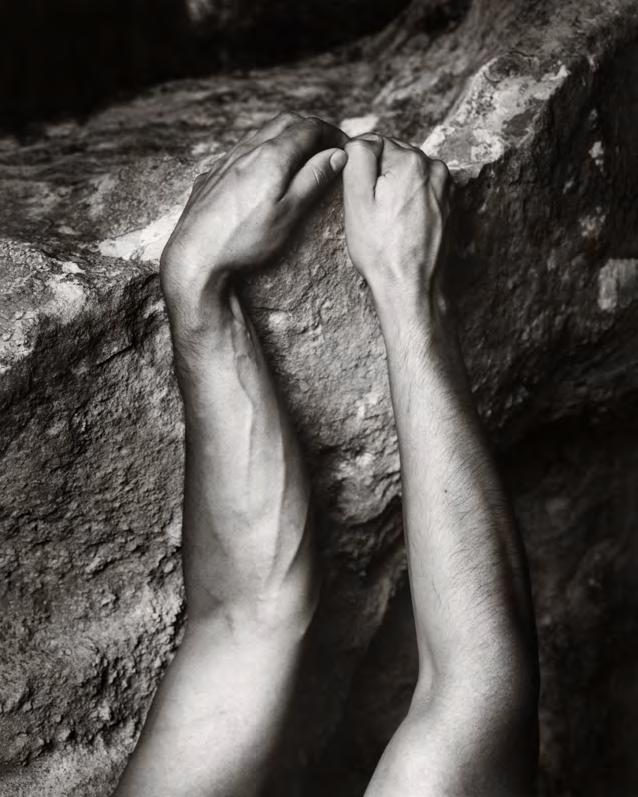
the foundations have been set for this to be a hobby and lifestyle of mine for the rest of my life
78
Harry on Tunnel Boulder

Fin MacMillan
Bouldering is an addiction—an obsession. The bigger the climb, the bigger the hit. And every climbing junkie wants that cocktail of adrenaline, fear, and euphoria flowing through their junkie veins. Indoor bouldering is exploding at the moment, everyone has a friend who climbs. But, for me at least, whatever you do in the climbing gym is just practice for the rock face. That place where the gym goats flock each weekend to chip away at their projects, pushing hard to unlock their next move and
get another dose of adrenaline. It’s a powerful feeling, one hard to find anywhere else. As you climb on top of your completed boulder, feel the elevated breeze cooling your tired skin and the heat of the sun or the glow of the stars. That first deep breath you take feels never-ending as you pulsate with a euphoric thrill. You don’t get this in a gym or playing golf—and so I boulder.
79
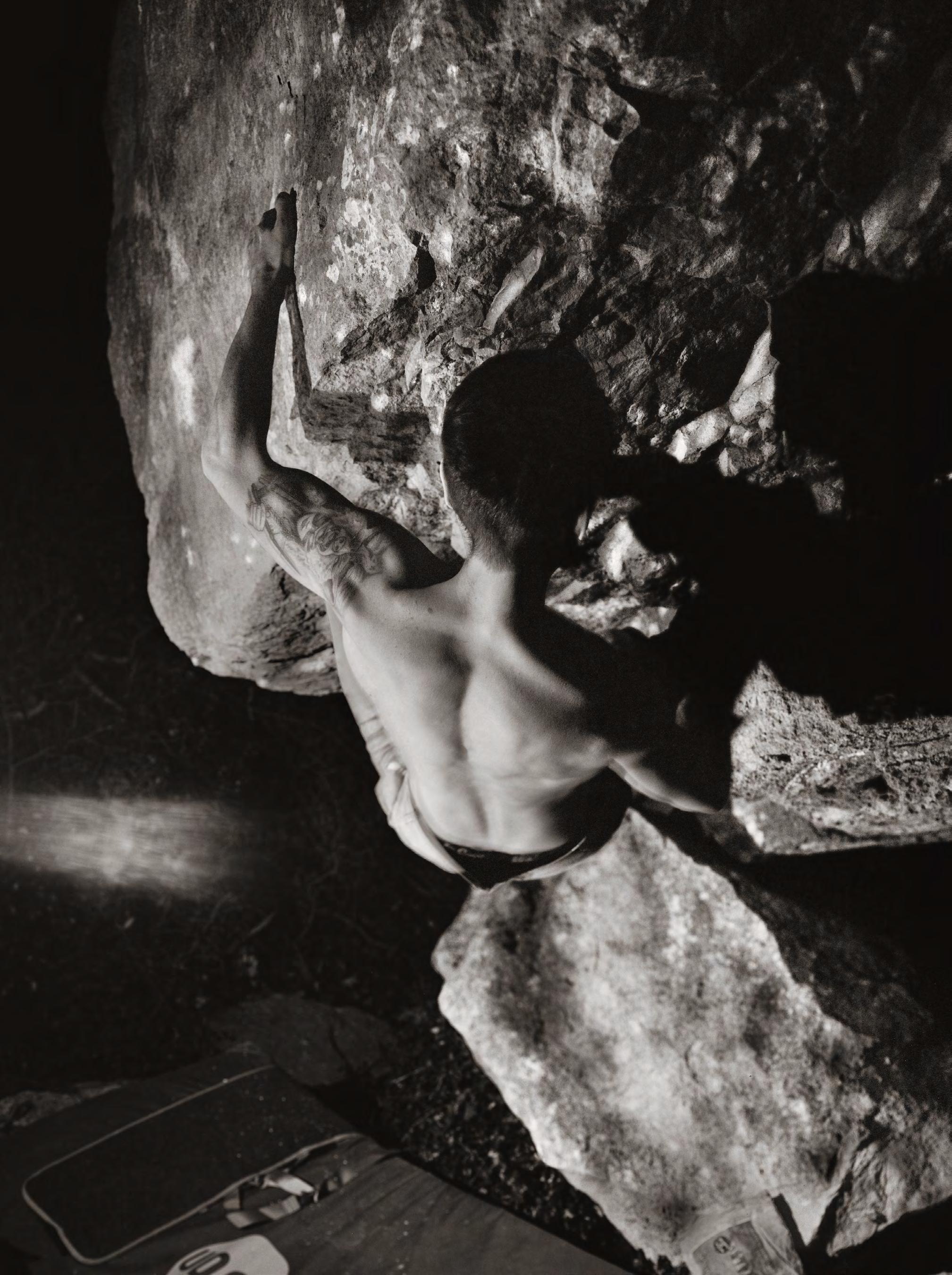 Kacey Snow
Kacey Snow
There’s no one comment that should accompany these pictures. In the same way, there’s no one reason I climb. One day my cut-up hands might fill me with accomplishment, the feeling of I worked my arse off, but another day they’ll simply remind me of how far I’ve still got to go.
In that regard, it’s not so different from anything you volunteer your time to, but it’s a simple display of my effort. When everything else in life seems so complicated, bouldering boils down to can I get from the bottom of this rock to the top of this rock, and no one’s going to make that happen but me.
On that note, if there’s one other thing, it’s the community. Never have I met a group of people so accepting, so diverse, and so willing to help. They make being cynical a little bit harder. Whilst only my hands can take me from bottom to top, often times, their support helps me realise I’m capable in the first place.
So why boulder? Because you can, and we’ll make sure you know it too.

when everything else in life seems so complicated, bouldering boils down to “can I get from the bottom of this rock to the top of this rock”
81
Kacey under Hut Boulder

82
Words & Photographs:
Olivia Thurlow Mills
The Best Bits of Van Life
@southcoastvanditis
The ‘ van life ’ isn’t all fun, freedom and games. Just like any other way of life, it comes with its own type of admin and pressures; a certain amount of drinking water on board, a non flushable toilet with a limit, battling with bad weather, a much smaller square footage than one may be previously used to. Not forgetting the task of finding where to stay for the night. I’ve spent the last year and a half living on the road and admin aside, the allure is next to none. Here’s a glimpse into the best parts of this lifestyle that make it the ultimate adventure on wheels.
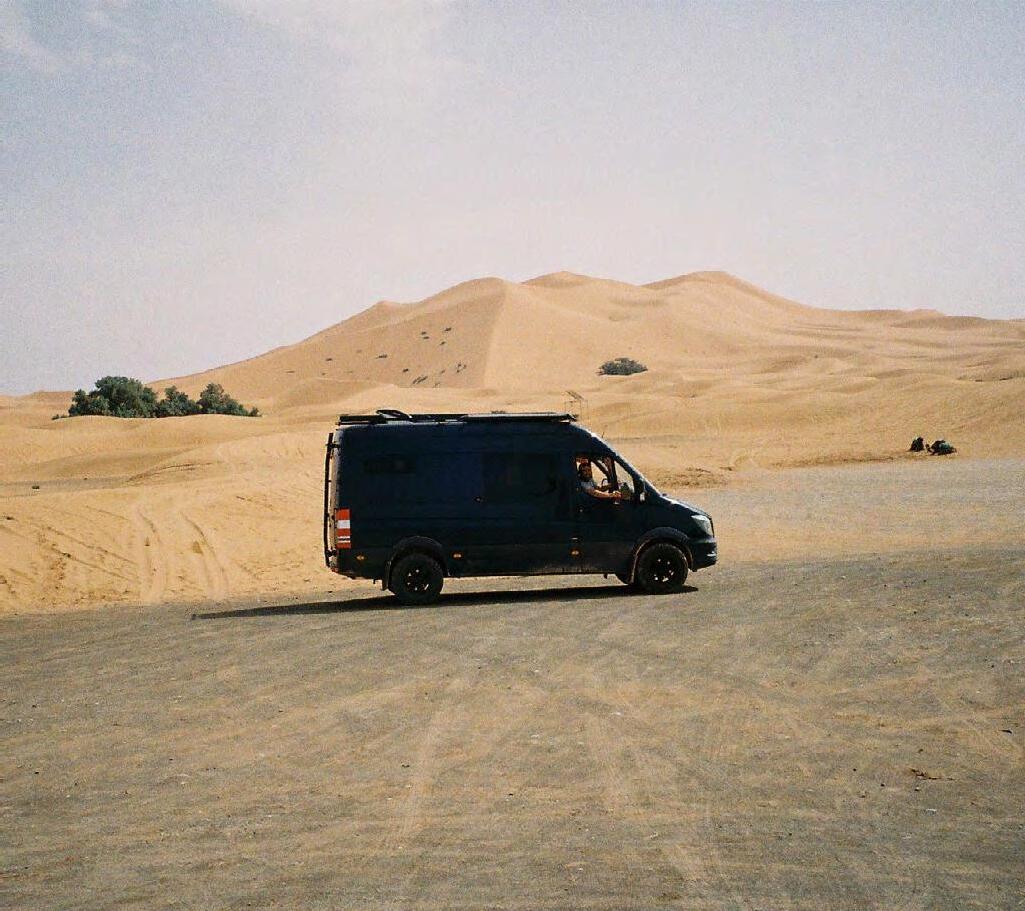
84

Flexibility in Spontaneity
In van life, plans need to be flexible. Whether it’s veering off the beaten path to discover a secluded beach or getting lost in the desert in search of a mysterious hot spring, to pivot, to adapt and to embrace spontaneity is key to unlocking hidden gems and unforeseen adventures.
Living with Nature
This lifestyle is guided by nature; from the strong pull of the wind, getting cabin fever from lashings of rain outside to feeling the sun warm up the world through your cabin window—you really feel connected with the outside and nature. One day you might be having a tense outdoor shower on bear watch in Romania, another you might be having breakfast with a herd of goats scuttling past your doors in the Albanian Riviera.

86
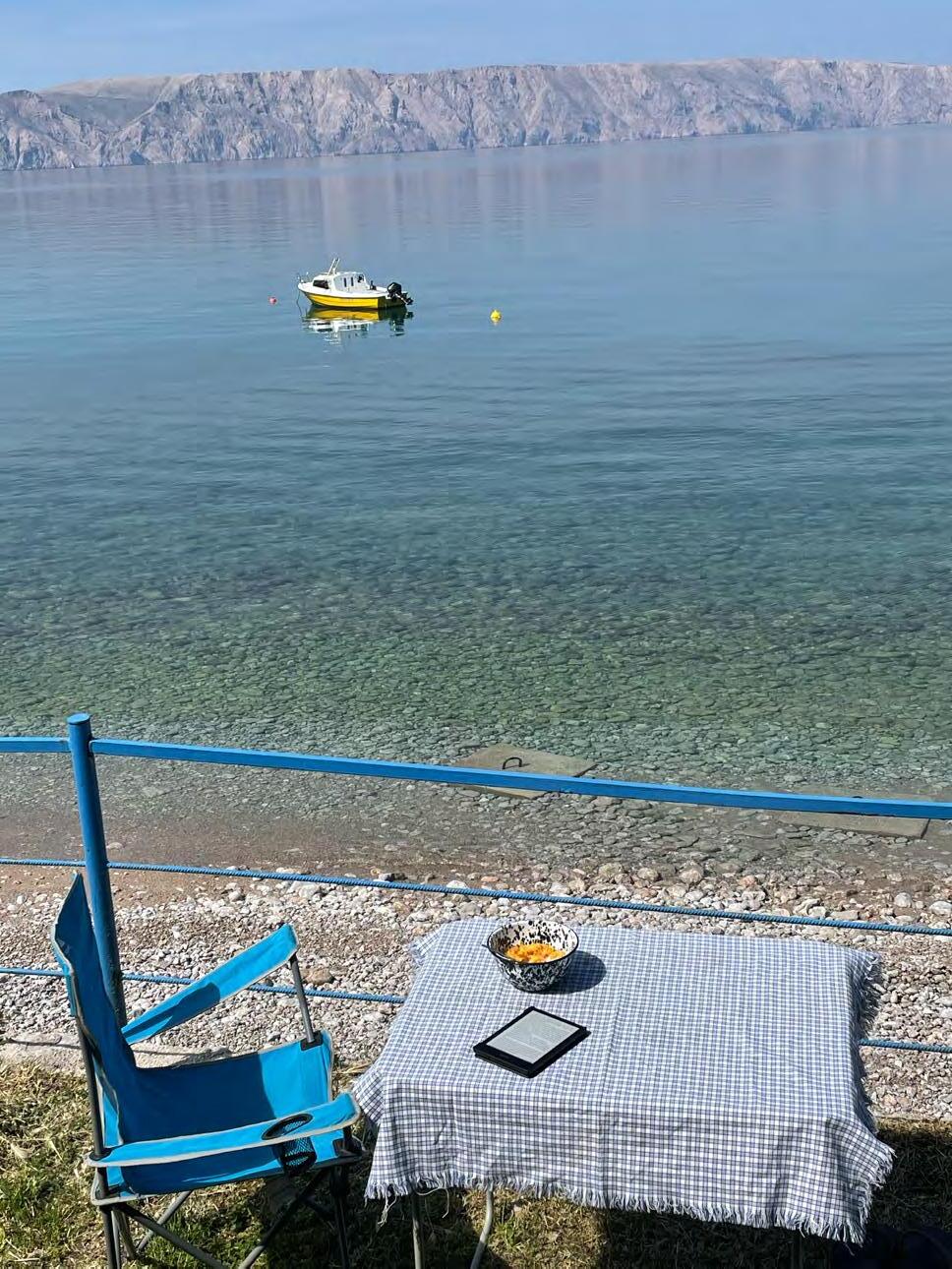
Epic Scenic Drives
Whether navigating the hairpin turns of the Dades Gorge in Morocco, cruising through the vastness of inland Turkey or aiming for the blue of the sea in the far distance, life on wheels introduces you to a gallery of ever-changing panoramas. Often the journey ends up being more significant than the destination itself.
Sunset. After. Sunset
The quintessential van life experience! Parked atop cliffs, nestled in forest or lakeside with your back doors wide open, you well and truly have a front-row seat to nature’s end of day masterpiece.

Freedom Beyond Borders
Whether it’s waking up to the gentle lull or wild roar of waves, prepping your Aeropress for your morning brew with mountain views, the freedom to choose your back garden is unparalleled. The road becomes your canvas, with every mile bringing new landscapes, cultures and experiences.
Community on the Move

From impromptu roadside gathering to shared campfires under the starry sky, the camaraderie among van dwellers is something special. As the trend continues there are many of us from all walks of life—the old school veterans, the weekend adventurers, the modern-day digital nomad. Our backgrounds may be different, our type of vehicle and style of conversion on other ends of the spectrum but there’s an unspoken bond there that you can just feel.
88


90 90
Story & Photographs:
Izzy Taylor

Solo Walking the SWCP

92
I’ve always wanted to walk the South West Coast Path (SWCP), a 1000km trail with 35,000m of elevation following the coastline through Somerset, North Devon, Cornwall, South Devon and Dorset in the South West of England. It's the longest trail in the country and is praised for its stunning scenery, dramatic geology, and quaint coastal villages.
The challenge of doing a solo thru-hike seemed like the perfect adventure.
93
93
The sun was still warm and high in the sky, glinting off pools of water scattered across the mudflats of the Bristol channel when we arrived in Minehead, Somerset at 3pm on the first Sunday of September. After a considerable amount of faff and last minute kit-packing, including sending my Dad running to find some lighters, I set out on the biggest adventure of my life so far.
The climbing began almost immediately as I zig-zagged up into the cool shade of woodland and tried not to be daunted by how many kilometres lay ahead and the complete lack of planning I had done. In my mind, I just wanted to walk however far I felt I could each day, enjoy the scenery, take lots of photos, chat to other walkers, be surprised around every corner and exist in the quiet of each moment. I just had to keep the sea on my right and keep walking. That first evening, after 14km, I pitched my tent and watched a watery pink sunset melt into the night and felt immensely happy.
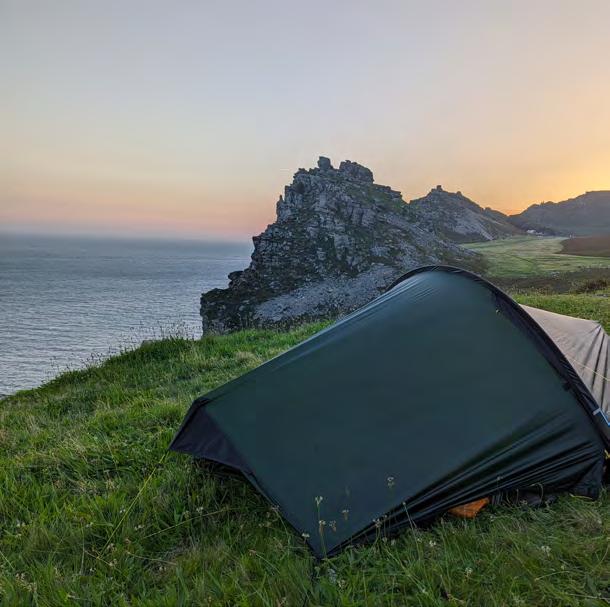
On day 6, nearly a week into the walk and over 130-km down, I was walking from Westward Ho! and aiming to camp somewhere past Clovelly. It was a hot and still day, the sun quickly burning through any low cloud as I walked along the rolling
cliffs listening to waves crashing on shingle below. I jumped into the sea around midday to cool off and met some other walkers on the overgrown track, I scrambled down to reach the shore.

As I was dressing, a sea mist swept across from the west and hid the sea within minutes. The air turned cool and damp, and the light instantly dropped. Later, as I began looking for a place to wild camp, somewhere flat and out of sight, the mist was still lingering between the trees and masking the sea below. I dropped down out of the forest onto a stoney beach enclosed on both sides by rocky cliffs crumpled into vertical strata and hugged by dense forest behind. Visibility was down to about 2m and it was eerily quiet. One empty van was parked at the edge of the trees.
After finding a few possible camp options but still nothing perfect, I scrambled up through some bracken behind an abandoned barn with a graffitied princess on the side. A flat space amongst some small trees, hidden by the barn but with a view of the beach, was perfect. After setting up camp, I returned to the edge of the beach to cook dinner and wait in hope that the mist would lift and I could see where I was. In the direction of the sea, the lull of the waves was disrupted
94
and low voices seemed to emerge from where I imagined the ocean to be. Two men clambered across the wet rocks holding spear guns and each with a bunch of long, sliver fish— bizarre but also not an out of place sight. Not much later, as if the secrets of the sea were ready to be revealed, the mist slunk away, sucked back out to sea, and a beautiful view materialised. The mist clung to the headlands in a lasting attempt to remain and I slept with the peaceful lapping of waves and no more unexpected surprises emerging from the sea.

Overall, I was very lucky with the weather. Being so exposed on the coast each day, I was at the mercy of the elements, and appreciated sunshine like never before. The first two weeks were hot nearly every day, hot for the UK at least! It was important to carry enough water, especially in the more remote sections where taps and cafés are sparse. Early on in my journey, I learned the lesson of resting out of the midday sun on the hottest days. I climbed Hangman’s Point, the highest cliff of the whole path, between 1 and 2pm on one of the hottest days of the whole path. I started to feel quite ill on the descent, unable to take on food, and feeling nauseous when I forced myself to. I knew I was getting
closer to the sea with each step so trudged all the way down with shaking legs. When I reached the beach, the tide was at its lowest point, so I had to walk what felt like another age to finally submerge my aching body beneath the surface to cool my core body temperature. I then re-fuelled with chips and an ice lolly and continued the walk feeling refreshed. I remember sitting outside my tent in shorts and a t-shirt at 10pm that night watching the lights of fishing boats trundle across my view and the stars appear in masses.
The contrast from that day to one of my last days on the path, when I woke up and the grass outside was crisp with frost and I had to quickly put on every item of clothing I was carrying before packing down the tent, made me appreciate the change of seasons. The gradual hemming of day length was noticeable every night. In early September, I set up my tent as the light dropped at about 8pm. On my last night, it was dark before 6.30pm. This made wild camping a lot easier, but considerably reduced daylight walking time.

I still can’t decide whether I prefer sunrises or sunsets, but felt incredibly grateful for each and every one.
95

96

97
Glossary [A mish-mash of words and terms which could be
Adventure Photography
The documentation of human focused meaningful stories, in the great outdoors, with a strong emphasis on the journey.
Bikepacking
Riding your bike for more than one day with all the kit you need (food, water, clothing, sleeping gear) strapped to your bike.
Bouldering
A form of free climbing that is performed on rock formations or artificial rock walls without the use of ropes or harnesses.
Digital Nomad
A person who earns a living working online in various locations, usually whilst travelling.
Micro Adventure
An adventure that is short, simple, local, cheap, but which is still fun, exciting, challenging, refreshing and rewarding.
Thru-hiking
Hiking a long-distance path from start to finish in one single trip, which can take anywhere from days to months.
Vanlife
Living, usually permanently, in a motor home or other vehicle that has somewhere to sleep and cook (and sometimes a toilet).
99
useful]

Thanks
Contributors [Friends / Adventurers]
Juliette Charpentier
Jean-Baptiste Delorme
Fin MacMillan
Alice Poole
Izzy Taylor
Olivia Thurlow Mills
Rosie Yates
Tutors [UCA]
Paul Crawley
Rob McDonald
Keith Sargent
102

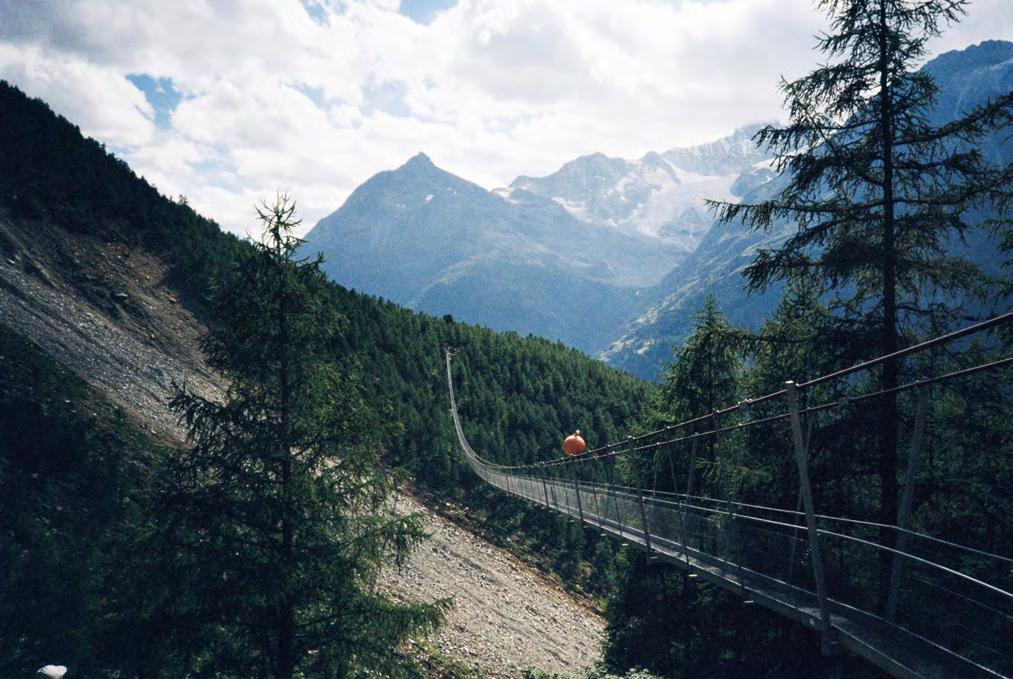




Original Freedom is for outdoor enthusiasts and adventurous minds, for those who seek wilder paths and meandering journeys, fuelled by curiosity and exploration, founded on the collective love of exploring the great outdoors; the original playground.
of
Adventure [Issue 01]
Archivists
Outdoor












































 Story & Photographs: Juliette Charpentier
Illustrations: Izzy Wedderburn
Story & Photographs: Juliette Charpentier
Illustrations: Izzy Wedderburn





































 Kacey Snow
Kacey Snow
























